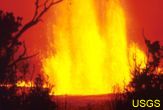Volcanoes Snuffed Out Most Life 250 Million Years Ago

Scientists have gone back-and-forth in recent years on what caused the various mass extinctions clearly evident in the fossil record. The worst of these, known as the Great Dying, occurred 250 million years ago. More than 90 percent of all species perished.
Experts are pretty sure an asteroid was behind a more recent mass extinction, which took with it the dinosaurs, about 65 million years ago. A more controversial recent claim has been that a similar impact caused the Great Dying.
But a new study finds no evidence for an impact 250 million years ago, at what is known as the end of the Permian Era.
Wrong calling cards
A team of scientists led by Christian Koeberl from the University of Vienna studied rock samples in sections of the planet's crust in Austria and Italy that are dated to the end-Permian extinction.
"Our geochemical analyses reveal no tangible evidence of extraterrestrial impact," Koeberl said. "This suggests the mass extinction must have been home-grown."
Asteroids bring elements to Earth that are rare here. Excess iridium, helium-3 and osmium-187, for example, can serve as calling cards for a space rock. In a series of previous studies, a group led by Luann Becker of the University of California, Santa Barbara has claimed evidence from other locations for such extraterrestrial signatures, all associated with the end-Permian event. Several scientists have doubted those results, however.
Get the world’s most fascinating discoveries delivered straight to your inbox.
The new study found only very small levels of iridium in the 250-million-year-old rocks, and revealed no traces of helium-3 or osmium-187.
There might have been several causes for the extinction, Koeberl said in an email interview, "but right now volcanism appears as the main culprit. I don't think an impact was involved in this case."
Choking the air and sea
The slight concentrations of potentially extraterrestrial materials were probably instead deposited by chemical interactions involving low oxygen levels in the ocean and high levels of carbon dioxide in the atmosphere, Koeberl said. The likely cause of the excess carbon dioxide: volcanic activity. That new interpretation is based in part on a more detailed analysis of the composition of the ancient materials by Koeberl's group.
The researchers also cite other recent studies that suggested the extinction occurred at the same time as extensive volcanic activity in what is now Siberia.
Here's what might have happened:
Long ago, theorists say, all the continents were huddled in one giant landmass called Pangea. Ancient spurts of volcanic activity sometimes cause huge cracks, allowing new oceans to form and leading to the separated continents we know today.
A similar event at the close of the Permian -- but one that did not form a new ocean -- flooded the atmosphere with gas and dust, altering the climate and making life impossible for many species, Koeberl's team concludes.
The research is detailed in the December issue of the journal Geology.
Supercontinent
Pangea began to break up about 225-200 million years ago. This animation shows how it unfolded.
SOURCE: USGS
Robert is an independent health and science journalist and writer based in Phoenix, Arizona. He is a former editor-in-chief of Live Science with over 20 years of experience as a reporter and editor. He has worked on websites such as Space.com and Tom's Guide, and is a contributor on Medium, covering how we age and how to optimize the mind and body through time. He has a journalism degree from Humboldt State University in California.


